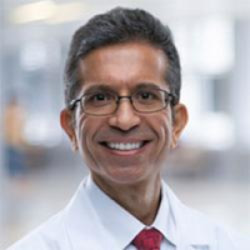“I am not feeling good about my life.” It was 3 a.m. in San Antonio, Texas. “I do not know if life is worth living.” Those words jolted me out of sleep. My friend, an intensivist, called me in a state of guilt and despair.
Medscape’s physician suicide report in 2022 found that one in 10 physicians considered or attempted suicide in 2021. Medical burnout has reached epidemic proportions; an overwhelming 63% of physicians reported burnout in 2022. As a urologic cancer surgeon in academics, juggling research, clinical productivity, and work-life integration, I also experienced burnout during the pandemic. I was fortunate enough to enroll in a local yoga studio, which, combined with the robust support of family and friends, tremendously helped me. However, with personal burnout experience and several friends in academic medicine, I thought about developing a structural framework to cultivate a sense of belonging, identity, and purpose. I pondered over the idea that if we could create a socially cohesive tribe, can we transform our quest for wellness into a shared tribal vision?
I remember the yoga class where the teacher said:
“Close your eyes.”
“Breathe in.”
“Breathe out.”
“Stay present.”
How do I stay present and connected with my tribe? What can I do within my sphere of influence to engage and create an atmosphere of trust to promote wellness among clinicians and research colleagues?
Over the past two years, studies of academicians in the medical field have shown dissatisfaction with work-life integration, rising depression, and emotional exhaustion. Yet, despite that, there is no framework for improving mental health and well-being in the workplace.
An opportunity for me to do something tangible finally came. The yoga studio where I was taking classes offered a 10-month yoga teacher training course. The training was designed for busy professionals, therefore, scheduled on Friday nights, Saturdays, and Sundays. Logically, this was perfect. I would train, become a certified yoga teacher, and then train colleagues in mindfulness and yoga. However, I struggled with the decision to train or not to train. On my only weekends off from work, I would miss out on my daughter’s recitals, piano/violin classes, golf lessons, and time that could be spent bonding with the family.
My wife, a pediatrician, provided clarity of vision, “Just do it now. It cannot get better than this.”
My daughter, age 10, chimed in, “You have to follow your dreams.”
The first two weekends of training in the yoga studio were challenging. I deeply regretted taking time away from the family, sitting in a small room, and listening to lectures on mindfulness and the primal need for silence. I experienced tremendous guilt about not using the time wisely to generate academic currency of research papers, abstracts, and grants. I thought I had made a wrong decision, but I persevered. Over the next 10 months, I bonded with 22 classmates as we trained on learning yoga postures and breathwork. We shared stories of adversities in life, celebrated each other's victories and shared food as we worked together.
After graduating from the yoga teacher training, I contacted the local yoga studios to collaborate in free yoga and mindfulness classes for the medical (clinical and research) community in the San Antonio area. I incorporated yoga postures to address the poor ergonomics of clinicians working in the hospital, surgeons in the operating room, and researchers working long hours in front of the computer.
Fully aware of the time constraints of a busy clinician and researcher, I tailored the yoga practice to 50 minutes, with 50 postures, and an additional 10 minutes for breathwork/mindfulness. By word of mouth, the medical community started coming to the free weekend class. Local charitable organizations started to support the effort financially. I could pay the local fitness center to rent a heated yoga studio space. The class, which has 30 spots, started getting booked within 30 minutes of opening. I started live streaming the class to accommodate people on the waitlist. I shared the link for the live stream with colleagues and friends, including the intensivist who had called me a few months ago. In the past 12 months, we have trained more than 400 health care workers and researchers.
Based on initial qualitative responses from the yoga class attendees, I realized that breaking the silence around burnout is imperative, and a proactive, grassroots-level systematic approach to address it is critical for the future of academic medicine. After the yoga class, I received feedback like, “My back and joints do not hurt anymore in the operating room and in clinic,” and “I can deal with negative thoughts by practicing mindfulness.”
Globally, health care workers face intense pressure, stress, and neglect wellness. There is an urgent unmet need for grassroots-level programs to promote wellness and prevent burnout. As I reflect on the journey toward establishing a small yoga, mindfulness, and ergonomics program in the San Antonio, Texas, area, I learned that by fostering a sense of yoga tribe, yoga community, and connectedness with colleagues, separate from the constraints of clinical practice or research collaboration, can be uplifting and galvanizing. Moreover, such grassroots-level programs can provide a much-needed framework for promoting wellness in academic medicine.
What have you tried to promote wellness for yourself or others? Share in the comments.
Dharam Kaushik MD, MS, is a urologic cancer surgeon in San Antonio, Texas. He is also a certified yoga teacher and teaches yoga, mindfulness, and breathwork exclusively to health care workers on weekends for free. He can be followed at Twitter: @DharamKaushik5.
Image by Alphavector / Shutterstock







